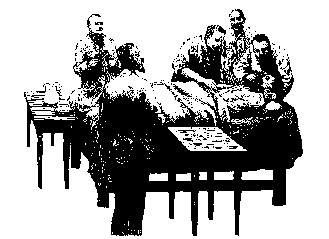The Flesh
The Body in
Medicine
Katharine Young
(Harvard)

Young's work is divided into four parts:
- internal medicine,
- gynecology,
- surgery, and
- pathology
Drapes, gloves, eye aversion, and leg position interpoise evidential boundaries between the physician and his perception of the patient. The intent of these arrangements appears to be to ensure that this, the touchiest of transactions, can transpire wholly within the reframe; the patient wholly object, silent and passive; the physician wholly operator, concentrated and active.
Physicians must...be concerned not to show too much attention to bodies as selves. Some parts of the body are incorrigibly symbolic, especially the sexual parts. Because sexual attentions to the body can also involve its disarticulation into parts, the examination of breasts, genitals, or buttocks is hedged with further evidential boundaries...
Remember --- the only strangers that can get us to take off all our clothes without protest are doctors and prostitutes (or, under protest, someone with a gun or a knife.) Lovers and morticians can get us to strip, too, but the former aren't strangers, and the latter get to our bodies when we are beyond caring.
Young is concerned with showing us the techniques that are used to keep the patient's dignity quiescent while he or she is being dehumanised in the physicians office. The writer is concerned, for example, with the structure of the clinic: cubicles, offices, desks (patient on one side, secretaries on the other --- desks which "guard" the entrance to the inner rooms.) And then there are the uniforms white jackets, or green or pink or black uniforms.
You and I will take off part or all of our clothes (often with the exception, she notes, of socks) while physicians will add a layer of clothing: a knee-length white coat. Listen to her observation on this discrepancy:
- The archeology of these artifacts is suggestive here: the layering of an outermost and predominant role over a complete social person as opposed to the reduction of a complete social person to a diminished role.
Further:
Physicians make their initial appearance already in costume for their role, whereas patients change costume in the course of the performance.
One of the strengths of Presence in the Flesh is that the author uses exact transcripts --- with special markings for clarity --- made during routine medical examinations to show how the doctors (in their role) and the patients (in their roles) use words and gestures and other artifacts to establish and maintain what she calls "the presence of the self." There are dialogues given here which convey a rich sense of drama, security (and insecurity) --- words, too, created to deflect from the situation. This, from an actual pelvic exam:
-
Dr C:
Let me check you below see how you feel.
Ms J: Something's hard right there occasionally.
Dr. C: Really?
Ms J: But I don't know what --- it goes away.
-
Ms. J: It's not like it stays there and it's anything to worry about. Least I don't think so.
Dr. C: [As he touches her vulva] Still riding your horse?
The author continues:
- This remark uttered (at the moment the gynecologist touches the most intimate part of her body) splits the woman's attention off from her embodiment on the occasion of the examination and redirects it to her embodiment elsewhere .... She is poised to tell stories, to recount a world in which she is sovereign even as she is perceptually bound to a world in which she is...abject.
Young goes on:
- Disembodiment supports the general medical project of objectification that is requisite for the specific gynecological attempt to insure propriety ... Dr C, therefore, invokes this in Evie Jones at just the moment he touches her body. As he touches her breast, the doctor asks,
"How's your legal battles?
As he touches her vulva, another question:
"Still riding your horse?"
And as he inserts his hand into her vagina,
"When were you in South Africa?"
Thus, the gynecologist occasions the creative act by which the woman can reconsititute herself.
- Having or being a self is not a condition of life; it is a social accomplishment. The person and his body merely provide the peg on which something of a collaboratative manufacture will be hung for a time.
Young, being an anthropologist, can sometimes befuddle us with her words:
- Because the body as a locus of self is imaginary, the embodied person must be constantly reconstituted, reinvented, intended, to take up the phenomenological term...I am complicit in the invention of my own subjectivity.
But this confusion is rare. Ignore the $100 words like "ontological" and "reframe" and "ineluctable discontinuities." The story to be told here --- you and me and our very strange relationship with our doctor, accepted by all "civilized" persons --- is worth every moment you spend with this tome.